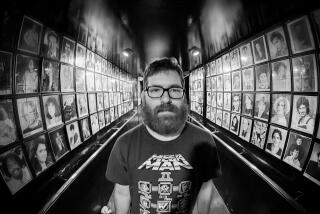Love Among the Haystacks and Elsewhere...
Early in 1915 D.H. Lawrence, the son of a coal miner but a rising novelist and the self-styled âpriest of love,â visited Bertrand Russell and his friends at Cambridge. He came away from Cambridge âvery black and down,â unable to bear the âsmell of rottenness, marsh-stagnancyâ there. He described this visit as âone of the crises in my life.â
Ironically, it is the Cambridge University Press that is completing Lawrenceâs literary canonization. Since 1980, Cambridge has been publishing newly edited texts of Lawrenceâs works, including the novel âMr. Noon,â two-thirds of which had never been published. âWomen in Loveâ and âLove Among the Haystacksâ are the ninth and tenth volumes in the edition, with many more to follow.
Cambridge has also been issuing a new edition of Lawrenceâs letters. Lawrence ranks as one of the centuryâs greatest and most voluminous correspondents. Though most of his 6,000 letters have been previously published, they are scattered in dozens of books and journals. The complete Cambridge âLettersâ will fill seven volumes and total more than 4,000 pages.
Volume 5, covering 1921-1924, finds Lawrence at his most restless. He complains that his âheart and (his) soul are broken, in Europe,â and he leaves Italy for Taos, by way of Ceylon and Australia. Feeling spurned by his native England, he wants to take root in the country that had become his major market. His journeys would also take him to New York City, Chicago, and Mexico City, and he spent September, 1923, in Los Angeles, Santa Monica, and Palm Springs. As the âold world gave way to a new,â he felt renewed hope.
The best letters brilliantly and energetically evoke the world Lawrence traveled through. Ceylon is âlike a prison over you: the palm trees and the noise and the sullenness of the forest.â âQueer, grey, sadâ Australia is âempty, and as if it would never be filled.â The âsteel rails in ribbonsâ of the streets of San Francisco are like âthe path of death itself.â Los Angeles is âsilly,â and all the driving around (in 1923!) made him âtired and vague.â California âhas turned its back on the world, and looks into the void Pacific.â Consider it a compliment when the irritable Lawrence declares that California is ânot so bad, in some ways.â
Most critics consider âWomen in Love,â first published in 1920, to be Lawrenceâs masterpiece and one of the great modern novels. In this turbulent book, Lawrence passionately attempts to reinvent love in a dying, destructive world and also to imagine an intense new relationship between men.
The published editions of âWomen in Loveâ have always been textually corrupt. Lawrence revised the novel extensively over four years, and many mistranscriptions entered the text. The original English and American publishers both nervously censored passages without telling Lawrence. A threatened libel suit also forced him to alter two characters and many details.
The newly edited âWomen in Loveâ will not strike readers as dramatically different, but the novel has gained in freshness and immediacy. The fascinating restored passages make the novel bolder. Birkin walks around Hallidayâs flat âin a state of nudity,â not âin white pajamas.â As he rolls naked among the hyacinths and fir-boughs, he knows âwhere to plant himself, his seed:--along with the trees, in the folds of the delicious fresh growing leaves.â Perhaps most striking is the deleted dialogue between Birkin and Gerald Crich, to whom Birkin has proposed a bond of blood-brotherhood. When Gerald argues that âthere can never be anything as strong between man and man as sex love between man and womanâ because ânature doesnât provide the basis,â Birkin responds, âI think she does. And I donât think we shall ever be happy till we establish ourselves on this basis.â
The Cambridge editions attempt to strike a balance between scholarship and popular accessibility. The text, presented clearly and readably, is of course the main feature. Most of the scholarly apparatus, including excellent notes, textual variants, Lawrenceâs 1919 âForeword,â and two early discarded chapters, are placed at the back. The introduction provides a valuable history of the novelâs composition, revision, publication, and reception.
âLove Among the Haystacks and Other Storiesâ is a minor volume in the edition. It brings together the early stories that Lawrence did not collect in his first book of short fiction, âThe Prussian Officerâ (1914). Still, such relatively little-known stories as the title story, âA Modern Lover,â and âThe Old Adamâ help demonstrate that Lawrence was the greatest 20th-Century British short story writer. These new Cambridge editions will help guarantee that heâll be around for a long time.
More to Read
Sign up for our Book Club newsletter
Get the latest news, events and more from the Los Angeles Times Book Club, and help us get L.A. reading and talking.
You may occasionally receive promotional content from the Los Angeles Times.







